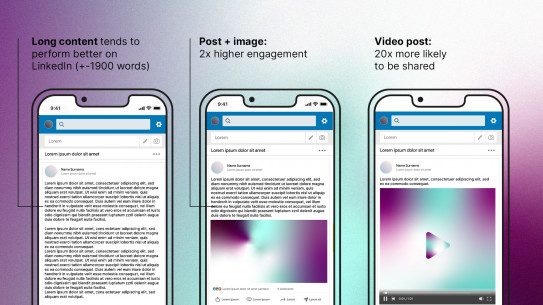
How to use LinkedIn as a brand awareness tool
Most of us know LinkedIn as a professional networking platform. But what if we told you LinkedIn shifted to an ideal channel for marketing and brand awareness over the last couple of years? Let’s find out what, how and why LinkedIn should be included in your marketing strategy!
- 810 M users worldwide
- 211 M active users in Europe
- 59.1% worldwide audience between 25-34y old
Why should you invest in LinkedIn?
First, let’s get some important numbers and statistics out of the way to illustrate why this social network platform might be interesting to use in your content strategy.
With 810 million users worldwide, of which 42.8% are women and 57.2% are men it has a huge reach potential. In Europe alone, there are more than 211 million active users. Even more importantly, about 59.1% of its worldwide audience is situated within the 25-34 age bracket, with 18-24- and 35–54-year-olds in tow at 20.4% and 17.7% respectively.
As a platform, it is regarded by executives – decision makers – as the best choice for relevant content, and educated people trust it as a medium. For B2B marketers, LinkedIn is the most popular social platform for organic social marketing (93%) . Moreover, 50% of its users have more trust in the ads they see on LinkedIn , and 92% claim to have a more purposeful mindset while browsing this social platform . This means they are not mindlessly scrolling through content but are actively looking for interesting insights and learnings to make a positive impact and increase growth.
LinkedIn, the career network?
LinkedIn is still largely associated with being a career platform, a social network for building and sustaining a professional network, and the content that can be found there are HR best practices and IT insights. That might have been true once, but over the last couple of years LinkedIn has provided several new features to support and encourage content creation and brand awareness, no matter the product or service.
So, what are these tools, how can you use them, if you aren’t already doing so, and why should you?
So why isn’t everyone using LinkedIn?
So far, most content associated with LinkedIn is generated by technical brands, the IT sector, software companies, marketing professionals or, truer to its roots, HR-related content, welcoming new employees, training programs and more. Basically, content to convince potential employees to come work for this or that company. This technical and HR focus means that LinkedIn is not always top-of-mind for brands who want to start generating content. But LinkedIn should be actively used in your branding strategy, and not just for HR purposes.
How you can start using LinkedIn
Luxury brands and non-technical brands, even medical suppliers are starting to find their way to LinkedIn as a branding tool. For example, in 2020-2021 pharma brands like AstraZeneca, BioGen & Aboot were using LinkedIn to reach physicians and cut through the noise of the cluttered media landscape professionals are confronted with on a daily basis. Through educational visuals like infographics detailing specific symptoms, concise and informative language for a clear message, and specific targeting of a clinical audience (like doctors, nurses, other healthcare professionals) they made the most of the purposeful mindset of most LinkedIn users.
However, as a digital content creator, I see there are still opportunities to be explored for European brands to make a mark. Cosmetic brands might take a leaf out of L’Oréal’s LinkedIn approach: with more than 4 million followers on LinkedIn they strive to strike a balance between employer content (like posts about new employees, and training programs) and brand awareness; the latter focusing on the full story that surrounds your brand (its origins, values, products or services). By celebrating professionals, building trust and providing quality content, a good brand awareness strategy has excellent drivers for success.
Some of my pointers in getting started with your brand awareness on LinkedIn
Create a complete profile:
- Profile picture: make sure you have got a recognizable, clear visual to use (e.g., an attractive logo), ideally 300 x 300 pixels as recommended by LinkedIn
- Background photo: this is the header photo at the top of your profile, consisting of 1400 x 425 pixels. You can use this space to have a hero image with your brand tagline, so it truly represents your brand. Alternatively, you can put an image containing text that drives people to engage with your content or a Call-To-Action.
- About/Biography: take the time to write an engaging text about your brand or company. Make sure to mention your core values, and include practical information, like a career page for example.

Create posts that are relevant to your target audience, and make sure you know what you are aiming for in terms of KPIs (Key Performance Indicators). For example: if you want to inform a target audience known for scanning their feed, keep your copy short, and your visual structured and clear. Did you choose engagement (likes, shares, comments) as your KPI, or would you rather direct traffic to your website or blog; mention what you want as engagement (like, share, comment below) or drive them to your website by teasing the content, and a clear CTA like “discover it now”.
- And keep in mind:

LinkedIn and 2022 social media trends
At the end of 2021 StudioID , a global content studio based in the US, surveyed marketing managers and businesses to isolate some marketing trend predictions for the upcoming year, and posted an interesting webinar about the results . According to those predictions, LinkedIn might be just the platform for your brand. Here is what they found:
One story across different platforms, because like people a brand or a company consists of several facets. Instead of highlighting fragments of your brand, depending on the platform, a holistic approach strives to unify all those facets into one, unique brand story. For example: sales, your employees, your products or services are all part of your brand; one influences the other, so this should be reflected in your brand marketing approach. To bring your story to potential customers or fans of your brand, you could use different platforms, but beware: choose your platforms wisely so you stay relevant. It is better to be in fewer places well, than scattered across various platforms and your story and products get lost in the noise.
There is a noticeable shift towards human-to-human marketing. The notion that a social media user is a human, whether they are a CEO, a decision maker, or a hairdresser, and a social media marketer is human as well; content creators should start creating content from their human perspective, aimed at another human, not a just a job title or a collection of interests.
As LinkedIn has got a unique position in terms of audiences – educated, experienced people, who are not necessarily very active on other social media – and within a very interesting age bracket of young decision-makers (24-35) as well, this human-to-human interaction makes it easier to convey your message. It is no longer necessary to use jargon, which makes LinkedIn a viable option for brands that are less technical or IT-oriented.
LinkedIn was the number one platform marketers and businesses indicated they would spend their marketing budget on. In addition to this LinkedIn also made sure content creation is encouraged, by publishing whitepapers like “Brand and Demand Approach” on how to balance your brand marketing over the long term and demand marketing to drive immediate growth, encouraging inclusive language so your audience is represented regardless of their gender or cultural identity , introducing dark mode to cut down on eye strain and help people with sensitivity to light, so people stay on the platform longer to engage with more relevant content.
My recommendation would be to use LinkedIn to inform; visually so you build brand trust and recognition, and by using short and long copy to inform your brand followers or drive them to action (e.g., purchase, download a brochure). No need to leave out the facts: as stated before, LinkedIn users love long copy. That’s why +50% of social traffic to B2B websites and blogs is pushed via LinkedIn.
You don't need to reinvent the wheel every time you want to post something on a social platform: use evergreen content – recycled content, stories or cases you have already told, but tell it in a different way – to tell your story.
LinkedIn works best when a brand engages with content made by employees or other parties, as long it is relevant. It is even considered a good practice according to their branding strategy guide. So, next to your holistic one-story-on-all-platforms approach, don’t hesitate to fall back on existing content within your content plan or sharing content you have shared before. If it is relevant to your brand, your story, your message, it can be a tool to build brand trust. Still want it to feel new: try to recycle it into a new format (blog article, carousel, podcast, infographic). For example: you have published a whitepaper about a certain product or service. Try recycling it into a short blog article in list format, or a powerful infographic for your social media. You could also record a podcast about this subject, with experts talking about the findings in your whitepaper, or convert it into an educational video. This way your content stays evergreen, no matter the platform.
Make LinkedIn your business
From a business and employment-oriented social media network to social media platform with room for content, LinkedIn is here to stay. Use it to round out your brand story, provide relevant information and trusted content so your brand loyalty can grow organically. In the end this will benefit all aspects of your business: your employer brand, your product brand, and even your bottom line.



